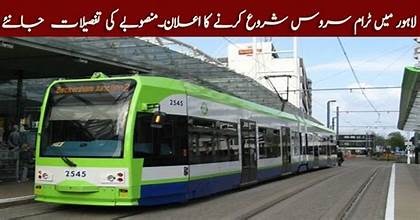In a striking leap toward sustainable urban transit, the Punjab government has announced the launch of Pakistan’s first electric tram service in Lahore. This pilot initiative underscores the province’s commitment to modernizing public transport, curbing congestion, and lowering carbon emissions—all while offering a fresh and efficient mobility option for residents.
⚡ Why Now? A Green Transport Revolution
Punjab has already rolled out electric buses and the Orange Line metro in Lahore. Building on that momentum, the electric tram system emerges as the next cornerstone of Punjab’s transport strategy, offering a trackless, battery-powered alternative that blends the convenience of buses with near-metro efficiency (ProPakistani, Dunya News). Designed to operate without conventional rails, the tram can glide seamlessly through traffic corridors like a subway, but at street level—significantly reducing infrastructure costs and construction disruption (The Express Tribune).
🚆 Tram Features & Pilot Route

- Three-compartment design, assembled at Ali Town Depot, with a seating capacity designed to transport up to 250 passengers per run (ProPakistani).
- Requires just 10 minutes of charging to travel 25–27 km, making it exceptionally efficient for short-urban loops (ProPakistani).
- Initially manually operated, though equipped for future autonomous capability—however operational safety remains the current priority (The Express Tribune, The Nation).
- Planned pilot corridor via Canal Road, particularly between Thokar Niaz Baig and Harbanspura, with demonstrations anticipated around early to mid‑August near Lahore Expo Centre (ProPakistani).
Officials have noted that the trams will be free of charge during the trial pilot phase. If the results are favourable, ticketing will be introduced for regular operation thereafter (ProPakistani).
📐 Tunnel Plans & Infrastructure Innovations

Long-term planning includes an underground corridor beneath Canal Road—executed via a “cut-and-cover” method—intended to host the trackless tram without disturbing existing green spaces or requiring tree removal (ProPakistani). The plan involves widening both sides of Canal Road by 12–14 feet and constructing a signal‑free, underground route, after which surface traffic restoration would follow (ProPakistani).
Though initial Yellow Line light‑rail proposals estimated costs at Rs. 80 billion, authorities are reassessing costs linked to the underground alignment. The underground option could offer a cleaner, greener transit alternative aligned with heritage conservation values in Lahore’s historic zones (ProPakistani).
🌆 Transport Strategy & Provincial Expansion
This tram initiative is part of Punjab’s broader five‑year transport modernization strategy launched earlier in 2025. At a February high-level meeting chaired by Chief Minister Maryam Nawaz, officials endorsed an Automated Rapid Transit (ART) network: trackless, electric vehicles capable of carrying up to 300 passengers, with features like onboard Wi‑Fi, CCTV, and solar‑powered charging hubs (The Express Tribune).
If the pilot succeeds, the plan is to expand tram operations to Faisalabad and Gujranwala within the current fiscal year—marking a province‑wide shift toward clean, accessible public transport (The Express Tribune).
🎯 Benefits & Broader Impact
- Environmental: Dramatically reduced emissions compared to fossil fuel buses, helping to combat urban air pollution.
- Cost-effective: Avoids building expensive metro rails; requires minimal infrastructure changes in the short term.
- Inclusive mobility: High capacity and accessible design promise to ease commuting burdens across socio‑economic groups.
- Legacy-preserving: Underground routing along Canal Road aims to protect Lahore’s historic urban fabric and greenery.
- Scalable: Trackless trams can be adapted to other cities in Punjab with relatively low-cost deployment.
🚧 Challenges & Risks Ahead
- Traffic integration: During the pilot, the tram will share lanes with existing vehicles—careful monitoring will be needed to assess whether dedicated lanes or additional traffic control measures are required (The Express Tribune).
- System reliability: Battery life, charging infrastructure, and operational resilience under real‑world conditions remain to be tested.
- Cost validation: Long-term feasibility depends on actual construction and operational costs versus projected budgets.
- Public reception: While many welcome innovative transport modes, some critics question allocation of resources—especially if benefits are not equitably realized (ProPakistani, Pakistan Observer).
✍️ What Lies Ahead?

In early August 2025, observers expect the first demonstration run for public and government stakeholders. The success of this showcase—and subsequent pilot performance—will likely determine whether ticketing is introduced or if the tram system is expanded city-wide.
Ultimately, this electric tram pilot could pave the way for a new transit era across Punjab: combining eco-friendly mobility with cutting‑edge tech and urban preservation.
Final Thoughts
Lahore’s electric tram initiative is emblematic of a turning point in urban transport policy in Pakistan. It bridges innovation in public transit, environmental responsibility, and urban heritage conservation. By launching this pilot, the Punjab government is not just offering a new mode of travel—it is testing the viability of a scalable, modern public transport blueprint that could reshape mobility throughout the region.



